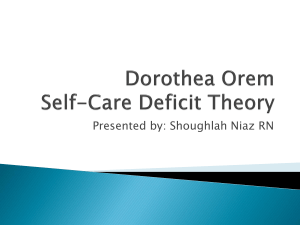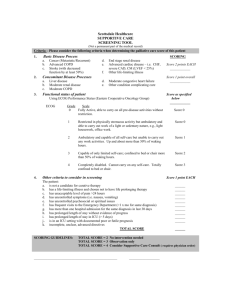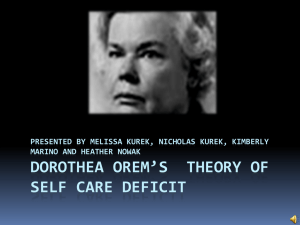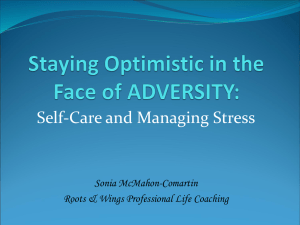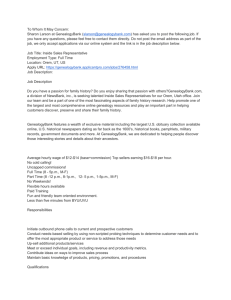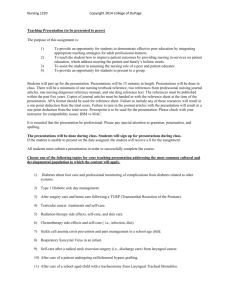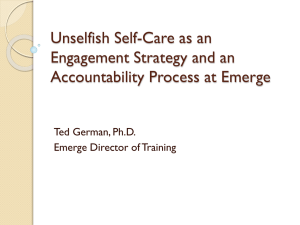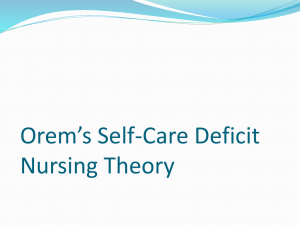Orem`s Self-Care Deficit Theory - Kari Walker
advertisement
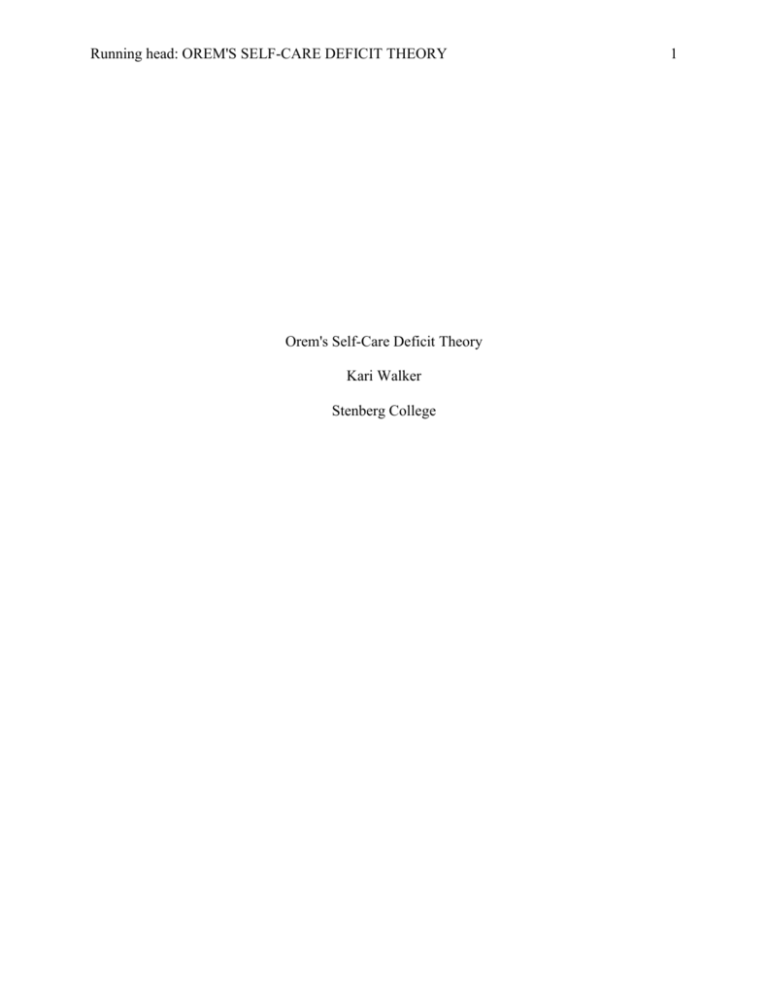
Running head: OREM'S SELF-CARE DEFICIT THEORY Orem's Self-Care Deficit Theory Kari Walker Stenberg College 1 OREM'S SELF-CARE DEFICIT THEORY Orem's Self-Care Deficit Theory Dorothea Orem’s theory is based on the belief that when a person is able to care for themselves, they should, and when a patient is unable to care for themselves, the nurse can provide assistance (Coldwell Foster & Janssens, 1990). It supports the promotion of an individual’s independence (Boyd & Parker, 2008). The simplicity of Orem’s theory makes it accessible to the beginning nurse, but also allows for more in depth study by a more advanced nurse ("Theoretical Foundations of Nursing," n.d.). It is proposed that these characteristics of Orem’s theory allows for its’ very relevant use within the psychiatric nursing community. An outline of the three main components of Orem’s Self-Care Deficit Theory will be given as well reasons why this theory in particular is very relative to the psychiatric nurse. Nice intro Theory of Self-Care The theory of self-care “focuses on the self, the I” (Orem, 1990, p. 49). The main principle behind the theory of self-care is that maturing or mature individuals contribute to their own well-being through learned actions that focus on health maintenance, disease prevention, control, or adaptation (Orem, 1990). The theory of self-care includes the concepts of self-care, self-care agency, therapeutic self-care demand, and self-care requisites. Self-Care Orem defines self-care as “the practice of activities that individuals initiate and perform on their own behalf in maintaining life, health, and well-being” (Cutler, 2003, p. 200). Orem (1995) points out that self-care refers to care given ‘for oneself’ or ‘by oneself’ (Fawcett & DeSanto-Madeya, 2013, p. 188). 2 OREM'S SELF-CARE DEFICIT THEORY 3 Self-Care Agency Self-care agency refers to one’s ability to participate in self-care activities. Orem (2001) identifies ten basic conditioning factors that affect one’s ability to participate in self-care activities. These factors include: age, gender, developmental state, health state, sociocultural orientation, health-care system factors, family system factors, patterns of living, environmental factors, resource availability and adequacy (Fawcett & DeSanto-Madeya, 2013, p. 188). Orem (2001) states that the self-care agency is the person who actually takes the action (Fawcett & DeSanto-Madeya, 2013). Self-care agency can therefore be subdivided into two categories: (1) Self-care agent which is defined as an individual who is capable of providing their own self-care and (2) Dependent-care agent which is someone who provides care for another (Fawcett & DeSanto-Madeya, 2013). Therapeutic Self-Care Demand Therapeutic self-care demand “is the totality of regulatory care measures required by persons at moments in time” (Orem & Vardiman, 1995, p. 169). Therapeutic self-care demand is an integral part of daily life. There are many different forms of self-care that will be required throughout one’s life. Self-Care Requisites Self-care requisites are related to daily functioning, development and well-being actions (Fawcett & DeSanto-Madeya, 2013). Orem (1995) states that the self-care requisites are “the reasons for doing actions that constitute self care” (Fawcett & DeSanto-Madeya, 2013, p. 186). Orem describes three categories of self-care requisites in her theory: universal self-care, development self-care, and health deviation self-care requisites (Coldwell Foster & Janssens, 1990). OREM'S SELF-CARE DEFICIT THEORY 4 Universal self-care requisites are activities associated with daily living; they are associated with life processes such as breathing, waste elimination, rest/activity balance, social/solitude balance, etc. ("Current Nursing," 2012). The goal of these requisites is the promotion of ‘normalcy’, where normalcy is defined as meaning “essentially human and that which is in accord with the genetic and constitutional characteristics and the talents of individuals” ("Theoretical Foundations of Nursing," n.d.). Orem (2001) states that these are common to all individuals at all stages of life “but adjusted for age, developmental stage, and environment” (Fawcett & DeSanto-Madeya, 2013, p. 186). Developmental self-care requisites are a specialization of universal requisites ("Theoretical Foundations of Nursing," n.d.). They can be conditioned or event driven ("Current Nursing," 2012) and are defined based on how they are met or challenged. The first are met with assistance of a dependent-care agent, the second are met by the self-care agent himself, and the third are challenged by factors that interfere with human development (Fawcett & DeSantoMadeya, 2013) Fawcett & DeSanto-Madeya (2013) identify health deviation self-care requisites as arising as a result of disease, injury, disfigurement, disability, as well as medical care measures. When health deviation occurs, one must seek and secure medical assistance, become aware of possible pathologic processes, follow prescribed medical treatments, modify behavior or selfconcept, or learn to create new processes (Fawcett & DeSanto-Madeya, 2013). Theory of Self-Care Deficit The theory of self-care deficit “focuses on you and me” (Orem, 1990, p. 49). A self-care deficit occurs when an individual has “a deficit in attitude (motivation), knowledge, or skill that impedes the meeting of self-care needs” (Boyd & Page, 2008, p. 85). OREM'S SELF-CARE DEFICIT THEORY 5 Another way to view this is that a self-care deficit occurs when self-care demands are greater than what the self-care agency (or dependent-care agency) are able to provide alone (Fawcett & DeSanto-Madeya, 2013). According to Orem (2001) these deficits can be partial or complete. Partial deficits are an inability to meet one or more of the self-care requirements while a complete deficit is when one is not able to accomplish any of the requirements for self-care (Fawcett & DeSanto-Madeya, 2013). Orem’s theory states that nursing is required when an individual is “incapable or limited in the provision of continuous effective self-care” (Coldwell Foster & Janssens, 1990, p. 93-94). In this circumstance, there are five methods of help suggested by Orem. These are: (a) “acting for or doing for another; (b) guiding another; (c) supporting another (physically or psychologically); (d) providing an environment that promotes personal development in relation to becoming able to meet present or future demands for action; (e) teaching another” (Coldwell Foster & Janssens, 1990, p. 94). Theory of Nursing Systems The theory of nursing systems “focuses on we, persons in the community” (Orem, 1990, p. 49). The nursing systems theory refers to “a series of actions a nurse takes to meet the patient’s self-care requisites” (Boyd & Page, 2008, p.85). According to Orem (1990), this is the most complex of the three theories. Although the nursing system is developed by the nurse, it is designed to be a collaborative effort between the nurse, patient, and support system (Fawcett & DeSanto-Madeya, 2013) and must be based upon the needs and abilities of the patient (Getty & Knab, 1998). OREM'S SELF-CARE DEFICIT THEORY 6 Orem outlines three levels of nursing systems to meet one’s self-care needs in her theory. These are a (a) wholly compensatory system; (b) partly compensatory system; (c) supportiveeducative system (Coldwell Foster & Janssens, 1990). In a wholly compensatory system the patient is not able to or should not participate in self-care activities (Fawcett & DeSanto-Madeya, 2013). These patients are “socially dependent on others for their continued existence and well-being” ("Theoretical Foundations of Nursing," n.d.). When a patient is able to participate in some, but not all aspects of self-care, they are considered to be in the partly compensatory system (Fawcett & DeSanto-Madeya, 2013). In this system, there is collaboration between nurse and patient regarding the care required and how the care will be achieved ("Theoretical Foundations of Nursing," n.d.). Fawcett & DeSanto-Madeya (2013) describe the supportive-educative system as one that is utilized when the patient can, and should, undertake self-care on their own. If a patient is presently not capable of undertaking self-care, they are at least capable of learning the skills required to do so (Coldwell Foster & Janssens, 1990). “Orem recognizes that specialized technologies are usually developed by members of the health professions” (Coldwell Foster & Janssens, 1990, p. 99). While this development of technologies has been noted, Orem “emphasizes the need for social and interpersonal dimensions in nursing” (Coldwell Foster & Janssens, 1990, p. 99). Orem suggests two separate categories of technologies: social or interpersonal and regulatory technologies (Coldwell Foster & Janssens, 1990). Orem’s social or interpersonal technologies are described as: (1) communication; (2) forming and maintaining interpersonal, intragroup, or intergroup relations; (3) bringing about OREM'S SELF-CARE DEFICIT THEORY 7 and maintaining therapeutic relations; and (4) giving assistance related to needs, action abilities and limitations (Coldwell Foster & Janssens, 1990, p. 99). Integration of the following regulatory technologies with the social or interpersonal technologies will promote “quality professional nursing” (Coldwell Foster & Janssens, 1990, p. 99). The following are regulatory technologies according to Orem: (1) maintaining and promoting life processes; (2) regulating psychophysiological modes of functioning in health and disease; (3) promoting human growth and development; and (4) regulating position and movement in space (Coldwell Foster & Janssens, 1990, p. 99). The Relevance of Orem’s Theory in Psychiatric Nursing Parker and Smith (2010) state that nursing theories are used by nurses to inform and guide their practice. When one chooses a theory to implement within their practice it will “color the way that (one) view(s) reality” (p. 22), how one relates to others, how one approaches others, and what then can be done with and for others (Parker & Smith, 2012, p. 22). In Orem’s theory, each person is viewed as an individual who has a unique set of skills and requirements. Campbell & Soeken (1999) state that the use of Orem’s theory in psychiatric nursing is extensive because of the emphasis on the promotion of individual independence and self-care activities (Boyd & Page, 2008). The Theory of Self-Care refers to one’s ability to care (or seek care) for themselves (selfcare). Mental illness can affect one’s awareness, power to choose, power to perform, and ability to prioritize (Orem & Vardiman, 1995). Pickens (1999) suggests that psychiatric nurses can support self-care relating to “symptom identification, monitoring and management” (p. 234). The psychiatric nurse is also able to help monitor treatment compliance and noncompliance which is associated with self-care (Pickens, 1999). OREM'S SELF-CARE DEFICIT THEORY 8 The promotion of ‘normalcy’ is one of the goals for the universal self-care requisites (Orem & Vardiman, 1995). Pickens (1999) suggests that the desire for normalcy may manifest itself in negative ‘self-care’ actions. Actions such as self-harm, failing to identify one’s self as having a mental illness, downplaying symptoms, etc. can all support the illusion of normalcy. The use of Orem’s theory can go a long way in aiding psychiatric nurses and their clients in the positive promotion of normalcy (Pickens, 1999). By identifying the underlying cause and hope behind the negative self-care actions the psychiatric nurse can guide and support the individual in learning more positive ways to achieve their desire for normalcy. Getty, et al (1998) state that although persons with chronic mental illness have a higher rate than the general population of medical illness, poorer health practices and higher mortality rate they are also less likely to utilize general health services. These facts provide ample opportunity for the psychiatric nurse to use her specialized knowledge and experience to provide care for this particular community of patients great point (Getty, Perese, & Knab, 1998). Within the Theory of Self-Care Deficit, Orem offers five methods by which a nurse is able to offer help: education, guidance, physical and psychological support, teaching, as well as the provision of an appropriate environment in which to learn. The psychiatric nurse can utilize her skills in these areas and aid the individual in acquiring the tools and skills required to begin meeting their own self-care requirements (Coldwell Foster & Janssens, 1990). Within Orem’s Theory of Nursing Systems, there are three systems available to aid one in meeting their self-care requirements: the wholly compensatory system, the party compensatory system, and the supportive-educative system (Fawcett & DeSanto-Madeya, 2013). The psychiatric nurse can operate on all these levels by assessing the individual to determine what (if any) self-care activities they are able to attend to on their own. Those activities that the OREM'S SELF-CARE DEFICIT THEORY 9 individual is able to attend to can, and should be completed by the patient. Those activities that the individual are not able to attend to, the psychiatric nurse and individual can then collaborate to determine the best course of action to meet those needs. Conclusion Orem’s Self-Care Deficit theory is very relevant for use in psychiatric nursing due to its emphasis on the promotion of individual independence and self-care activities (Barker & Page, 2008). The main theme within Orem’s theory is that an able individual can and should provide for their own self-care requirements; that every individual is unique and has a unique set of skills and requirements. Yes When mental illness affects one’s ability to provide their own self-care, the psychiatric nurse is able to utilize this theory to educate, guide and support the individual on their journey to regain their self-care abilities. OREM'S SELF-CARE DEFICIT THEORY 10 References Boyd, M. A., & Page, G. (2008). Theoretic basis of psychiatric and mental health nursing. In W. Austin, & M. A. Boyd (Eds.), Communication and the therapeutic relationship (pp. 8199). Philadelphia, PA: Lippincott Williams & Wilkins. Coldwell Foster, P., & Janssens, N. P. (1990). Dorothea E. Orem. In J. B. George (Ed.), Nursing theories - The base for professional nursing practice (3rd ed., pp. 91-112). Norwalk, CT: Appleton & Lange. Cutler, C. (2003). Assessing patients’ perception of self-care agency in psychiatric care. Issues in Mental Health Nursing, 24(2), 199-211. Retrieved from http://web.ebscohost.com.ezproxy.tru.ca/ehost/pdfviewer/pdfviewer?sid=1491b562-62ae4551-80a3-555daed502f5%40sessionmgr12&vid=9&hid=20 Dorothea E. Orem - The self-care deficit nursing theory. (n.d.). Retrieved August 3, 2013, from http://nursingtheories.weebly.com/dorothea-e-orem.html Dorothea Orem’s self-care theory. (2012). Retrieved August 3, 2013, from http://currentnursing.com/nursing_theory/self_care_deficit_theory.html Fawcett, J., & DeSanto-Madeya, S. (2013). Orem’s self-care framework. In Contemporary nursing knowledge - Analysis and evaluation of nursing models and theories (3rd ed., pp. 179-230). Philadelphia, PA: F.A. Davis Company. Getty, C., Perese, E., & Knab, S. (1998). Capacity for self-care of persons with mental illness living in community residences and the ability of their surrogate families to perform health care functions. Issues in Mental Health Nursing, 19(1), 53-70. Retrieved from http://web.ebscohost.com.ezproxy.tru.ca/ehost/pdfviewer/pdfviewer?sid=1491b562-62ae4551-80a3-555daed502f5%40sessionmgr12&vid=4&hid=20 OREM'S SELF-CARE DEFICIT THEORY 11 Orem, D. E. (1990). A nursing practice theory in three parts, 1969-1989. In M. E. Parker (Ed.), Nursing theories in practice (pp. 47-60). New York, NY: National League for Nursing. Orem, D. E., & Vardiman, E. M. (1995). Orem’s nursing theory and positive mental health: Practical Considerations. Nursing Science Quarterly, 8(4), 165-173. http://dx.doi.org/10.1177/089431849500800407 Parker, M. E., & Smith, M. C. (2010). Choosing, evaluating and implementing nursing theories for practice. In M. E. Parker, & M. C. Smith (Eds.), Nursing theories and nursing practice (3rd ed., pp. 20-31). Retrieved from http://stenbergcollege.mrooms3.net/pluginfile.php/42214/mod_resource/content/0/Choosi ng_Evaluating_and_Implementing_Nursing_Theories.pdf Pickens, J. M. (1999). Living with serious mental illness: The desire for normalcy. Nursing Science Quarterly, 12(3), 233-239. http://dx.doi.org/10.1177/08943189922107007 OREM'S SELF-CARE DEFICIT THEORY 12 OREM'S SELF-CARE DEFICIT THEORY Basic Concepts First Essay APA APA format for body of paper, references with consistent and complete identification of sources Structure and Scholarly Presentation Well-structured paper, logically & coherently developed including a rational progression of ideas, intelligent use of sentence and paragraph sequencing Length: 2000 words (+/- 10%) Appropriateness of word choice and language including correct spelling, punctuation and grammar 13 Mark Assigned Mark Earned Comments 5 5 Compliant to all APA standards and format 5 5 Well written with a coherent progressions of ideas, 3 3 Well proofed, no major spelling, punctuation or grammar issues noted Content Theoretical approaches to nursing No differentiation of nursing theories from other theories 4 3 differentiated from theoretical but good background given. approaches to psychology, counselling, psychiatry and psycho-analysis Overview of theoretical approaches to Not much comparison to other nursing approaches, but 5 4 psychiatric nursing with one approach good introduction to topic. identified in the thesis statement at the end of the introductory paragraph Each topic sentence of each paragraph Would have liked some more exploration of evolution of 4 3 introduces the point of focus for that this theory and some statistical or anecdotal outcome data paragraph. Paragraphs describe the to support the continued use of this model. evolution of this theory, exploring its validity and use. The final paragraph summarizes the Good summation 4 4 main points that you discussed in your essay and restates your thesis statement, concluding (proving) why this theory is important to psychiatric nursing today. Total Mark 30 27 Late Penalty (if applicable) Final Mark 27 Good job Kari, you have demonstrated a good understanding of Orem’s model and its applicability to psychiatric nursing today. I would have liked to see this supported with some statistics and/or anecdotal outcome measures to prove this model’s validity as effective in a variety of clinical settings. I enjoyed reading your paper. Donna
